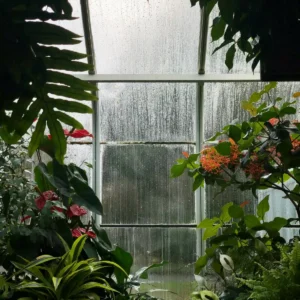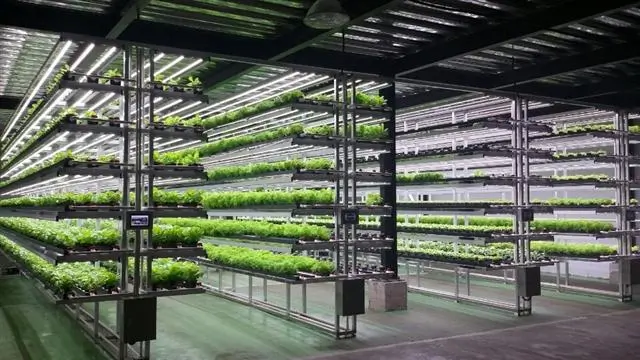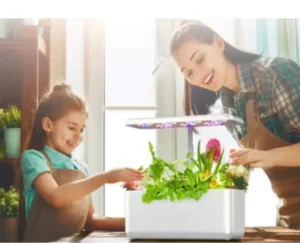Table of contents
ToggleHow much light should plants have?
It can be difficult to find out how much light all your different plants in the living room need in order to thrive and grow beautiful and healthy. Some types of plants need more light than others, and sometimes the same plant can have different light needs. How much light the individual plant needs depends on its position in its life cycle and of course also on the plant's species.
How much light should plants have? As a rule of thumb, most plants grow best with between 10 and 15 hours of light each day, but the number of hours of course depends on how high the brightness is. The brightness can be measured in µmol, and normally a plant must have at least 150 µmol to be able to photosynthesize effectively. In comparison, the sun provides only approximately 75 µmol in the winter, and around 1600 µmol in the summer.
As mentioned before, the number of light hours depends on the brightness. If a plant receives 300 µmol for 2 hours, it gives approximately the same as 600 µmol for 1 hour, however too strong light can be harmful in a few cases. In this way, with a higher amount of µmol, i.e. a stronger brightness, you can shorten the daily time period in which the plant needs light.
How much light should plants have in a greenhouse?
A greenhouse can be used for many things. It is warm and bright in the summer, and many plants can thrive and grow big and healthy in it, as long as they are given water and fertilizer - and the growing season for some plants can last well into autumn with only ordinary daylight from the sun.
With a few exceptions, it is usually 1-year-old plants that are kept in the greenhouse. To get as much as possible out of your very light-demanding plants, such as chili, cucumber, pepper and tomato, it is an advantage to use powerful grow light.
When we hit the dark times in autumn - there will no longer be enough light from the sun for your plants to thrive, here a grow lights so benefit extremely much.

If you choose to use grow lights in the greenhouse, you must be aware that there is often a lot of water in a greenhouse - both from watering, condensation and perhaps an open window that was not closed before it started to rain.
Checklist:
- Waterproof plant light/growth lamp
- Powerful variant, suitable for outdoor use
Read more about the use of grow lights and how much light plants should have in a greenhouse here.
How much light should plants have in an orangery or conservatory?:
An orangery is insulated and usually heated - this means that plants that cannot tolerate frost can overwinter there, and since it is heated, with the right light, it is possible to grow plants in the orangery all year round.
Unlike greenhouses, we often have perennial plants and trees in the orangery, such as citrus and olives for wintering, but with the right light, moisture and warm conditions, some of your orangery can be transformed into a place where you can grow different crops all year round, you can try experimenting with micro green at one end of the orangery, while the other end is for the overwintering evergreen plants that do not have such a great need for heat in the protected orangery.

When choosing plant lights for the orangery, you must remember:
- Familiarizing yourself with the light needs of individual plants - how much light should plants have?
- Thinking about where the light is placed - is there, for example, chance of it getting wet?
Read more about how you can find the perfect grow light lamp for you and your plants' needs
How much light should plants have in dark rooms, large tents and cellars?:
With the right conditions in relation to light, heat and water, it is possible to grow everything from microgreens to cucumbers, tomatoes and carrots - it's just a matter of meeting the plant's needs, and in a completely dark room you are in control of the whole the process in relation to growth light, moisture, fertilizer and temperature.
Remember list for dark rooms and grot tents:
- Grow lights – how powerful and how long each day?
- Good watering routine – automatic control is best
- Fertilizer adapted to the plant you grow, use liquid fertilizer
- Temperature control - choose a system that automatically starts the ventilation when it gets too hot.

How much light should plants have in the living room:
In your living room and other rooms in your home, the amount of light can vary greatly, it may be that the living room has a south-facing window sill and a dark corner in the same room.
If your houseplants are not thriving, it may be that they lack light - it may also be that you want to replace the traditional ornamental plants in the home with some sustainable edible plants, the possibilities are many and with the right plant light, both herbs and plants will thrive, even in the dark winter months.

Here is a list of things to think about:
- Is your plant getting enough light?
- Be careful with heat from e.g. radiators, heat can quickly dry out the soil and thus kill the plant
- Is it time for fertilizer or a new pot and fresh soil
With plant lights, you can control how much light your plants get
Since the sun in winter does not contribute a particularly large amount of µmol, it can be difficult to maintain plants during this period. This is where grow/plant lights come to your rescue. With plant lights, also known as grow lights and grow lights, you can check yourself that your plants get the right amount of light. There are countless kinds and types of plant lights, and if you are in doubt about which one suits you and your needs, you can contact us here. Du kan også læse mere om de mange fordele ved at vælge LED plantelys here.
How powerful a grow light should I choose?
How much light should plants have? The right LED grow lamp gives you the opportunity to grow your plants all year round, regardless of the weather and amount of sunlight. But how powerful does the grow lamp need to be in order for it to contribute to the greatest possible growth for your plants?
The table below gives you an overview of the amount of µmol that creates growth for plants. If you are interested in the amount of µmol specific plants such as the tomato plant, ferns or cut flowers need, you can click here.
So how much light should plants have? You can see this in the table below:
| 0 – 250 µmol/m-²/s-¹ | Gives no growth |
| 250 – 500 µmol/m-²/s-¹ | Gives little growth |
| 500 – 750 µmol/m-²/s-¹ | Gives moderate growth |
| 750 – 1000 µmol/m-²/s-¹ | Gives high growth |
| 1000 – 2000 µmol/m-²/s-¹ | Gives the highest growth, but requires CO2 addition. |
Be aware that this applies far from all plant types, see here how much light plants should have.





